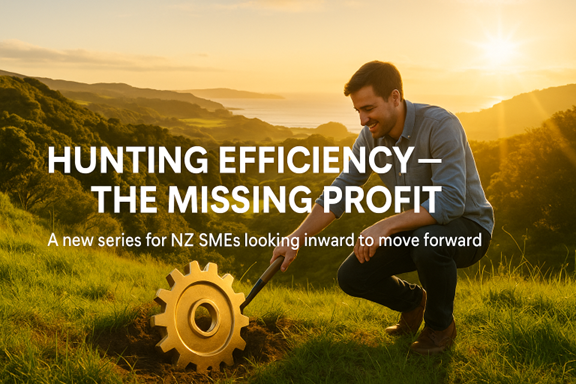28. Future-Proofing – Building an Adaptive Business
A series about business efficiency, finding profit and how to get there
Introduction
“Future-proofing” gets thrown around a lot in business circles. But what does it actually mean?
It’s not about predicting the future - no one can do that. It’s about designing a business that can flex, pivot and adapt - no matter what the future brings.
Whether it’s a supply chain crisis, market downturn, tech disruption, or extreme weather event, the businesses that thrive are not the biggest or the boldest - they’re the most adaptable and adaptability isn’t luck. It’s built through systems, culture and leadership decisions that prioritise learning, flexibility and responsiveness.
The future will reward businesses that are lean, agile and values-driven. That’s where real resilience and long-term profitability lives.
Actions to Be Taken
Here’s how to build adaptability into the DNA of your business - without overcomplicating it.
1. Stress-Test Your Business Model
Ask yourself (and your leadership team) -
What if our biggest customer left tomorrow?
What if we lost access to our main supplier?
What if demand dropped by 30%? Or spiked by 50%?
What if we had to operate remotely for 30 days?
Write down your answers. This isn’t a doomsday exercise - it’s a design challenge.
2. Diversify Where It Matters Most
Future-proofing isn’t about doing more - it’s about avoiding single points of failure -
Diversify suppliers, not just stock
Diversify income streams (services, products, clients)
Diversify skills within your team - through cross-training and knowledge-sharing
Redundancy (in the engineering sense) creates resilience.
3. Build Feedback Loops Into Every Function
An adaptive business doesn’t just react - it listens and evolves continuously. Set up -
Monthly debriefs with staff on what’s working and what’s not
Quarterly customer feedback reviews
Post-mortems on lost sales, errors, or missed opportunities
Use what you learn to adjust - not just record.
4. Invest in Strategic Agility, Not Just Efficiency
Efficiency reduces cost. Agility increases readiness. Build in -
Scenario planning (best, worst and wild card)
Decision frameworks for rapid response (who decides what and when)
Small buffers - of cash, time and capacity, that allow you to absorb shocks without snapping
Balance “tight” systems with “loose” thinking.
5. Nurture a Learning Culture
Future-proofing is 80% cultural. Adaptive businesses have teams that -
Learn from mistakes, not bury them
Stay curious about change
Try small experiments regularly
Feel safe to challenge the status quo
That doesn’t come from policy - it comes from leadership.
Psychological Perspective
Uncertainty triggers fear and fear narrows thinking. Many business owners default to -
“Let’s just get through this quarter.”
“We’ll worry about that when it happens.”
“It’s too hard to plan for what we can’t predict.”
But fear-led thinking leads to fragile business models.
Adaptive businesses are built by shifting the mindset from control to curiosity.
Instead of needing certainty, they ask What are we ready for? What options do we have?
This mindset creates calm, proactive leadership and a team that rises instead of retreats when the pressure’s on.
HR Best Practice
HR plays a vital role in shaping adaptability at the human level.
Here’s how -
Support cross-functional training so staff can flex with demand
Identify emerging skills gaps and create low-cost learning pathways
Reward problem-solving and adaptability, not just task completion
Create processes for rapid role clarity during disruption (who does what, if something changes?)
HR should also help track team resilience - burnout is the enemy of future-proofing. A resilient team is one that can bounce, not break.
Red Flags to Watch For and Mitigate Against
Your business may be too brittle and not adaptive enough, if -
One staff member holds critical knowledge
Revenue is highly concentrated in one product or client
Decisions take too long in times of uncertainty
Your team is anxious about change, or freezes under pressure
You’re always reacting to problems - rarely preventing them
These are not reasons to panic — they’re invitations to redesign for strength.
Narrative Story - Meet Te Aroha from Taranaki
Te Aroha runs a rural logistics company. When fuel prices spiked and driver availability dropped, her whole model was under pressure.
She paused, reviewed her assumptions and made bold moves -
Introduced electric vehicles for local runs
Partnered with a tech startup for smarter routing
Cross-trained admin staff to support dispatch
Built a three-month reserve fund and reviewed all contracts
The result? She didn’t just survive - she expanded into two new districts within the year.
Her insight - “We used to build for stability. Now we build for agility. That’s made us safer — and stronger.”
Golden Nugget
“Future-proof businesses aren’t built on certainty - they’re built on the capacity to change.”
If you’d like a confidential, free of charge, free of obligation conversation about your business, here’s how to get me.
📞 Phone +64 275 665 682
✉️ Email john.luxton@regenerationhq.co.nz
🌐 Contact Form www.regenerationhq.co.nz/contact
If you’d like to read more RegenerationHQ thinking on SME business and other things, go here – www.regenerationhq.co.nz/articlesoverview
🔹 RegenerationHQ Ltd - Business Problems Solved Sensibly.
Supporting NZ SME Owners to Exit Well, Lead Better and Build Business Value.

